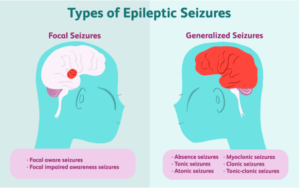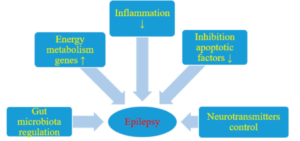Food for Thought: How Diet Impacts Epilepsy
Written by: Sahasra Janagama
Epilepsy is a common disease that impacts around 2.9 million Americans of various ages, genders, and races. How did different aspects result in a more positive outcome? Is there a way to prevent having surgery? Let’s discuss the different types of epilepsy and how to decrease the chances of seizures without the need for surgery, through a diet.
Overview of Epilepsy
Anyone can develop epilepsy due to the multiple factors ranging from genetic influence on injuries or developmental conditions before birth. Furthermore, people with epilepsy are typically categorized into two types of seizures: focal and generalized.
Focal seizures may originate in any lobe of the brain. One common type of focal seizure originates in the temporal lobe, which works with the emotions in the brain. When experiencing this seizure, a person usually loses consciousness and has a euphoric sensation in their stomach. Another example is a person undergoing a frontal lobe seizure involving the lobe in charge of movement. They may experience a part of their body being unresponsive and repetitive rocking movements. The occipital lobe is another common spot for focal seizures to originate, which involves vision and has an effect of causing people to have hallucinations.
Unlike focal seizures that only affect a certain part or lobe of the brain, generalized seizures can affect any part of the brain. An example is absence seizures where a person stares into space and blinks for 5 to 10 seconds, and they repeat this seizure over 100 times a day slowly losing awareness. A tonic seizure is another one that causes a loss of consciousness by stiffening the muscles in the body, causing the person to collapse.
One important note is that people who have been diagnosed with epilepsy often have triggers that can induce seizures. Typical triggers include alcohol, taking improper amounts of their required medication, a lack of sleep, dehydration, and skipping meals. Most of these triggers are not some abnormal activities but a daily occurrence for most people, so taking care of mental and physical health is crucial (Epilepsy – Symptoms and Causes, 2023).
Figure 1

Infographic shows the main differences between focal and generalized seizures.
Source: VeryWellHealth
Diet Aspect
An improper diet plays an important role in triggering epilepsy, and multiple studies show that a ketogenic diet is the best option for decreasing the number of seizures occurring. Since the 1920s the ketogenic diet has been known to be an effective option for treating people without involving surgery. A ketogenic diet consists of high fats and low carbohydrates because the main goal of the diet is to change the main source of energy from carbohydrates and sugars to fats. Therefore, the body will now start burning more fat and this in turn gives the brain a different kind of energy that is anti-epileptic. However, there are pros and cons to the diet, as a child may run the risk of hyperglycemia, as it takes time to adjust to the diet. It is important to avoid certain oils even though they are considered fats. Nevertheless, Cleveland Clinic children who started the keto diet have a 50% decrease in the number of seizures they have (Ketogenic Diet For Epilepsy / Seizures, n.d.).
Figure 2

Diagram displays all the different factors that play a role into epilepsy.
Source: PubMed Center
Conclusion
There are more effective methods to tackle a disease like epilepsy without the need for surgery. It’s important to note that the change in diet is a daily part of a person’s routine and that change takes time, and understanding this could help lead to more effective methods of treatment for other diseases as well. Furthermore, the interpretation of how even if a person experiences a different type of epilepsy seizure, the solution in the aspect of diet still stays the same. In conclusion, people have found more ways to treat people who have epilepsy through a change in diet compared to surgery or therapy.
References
Ellison-McPeters, A. (2024, August 20). The Role of Nutrition in Managing Epilepsy. Defeating Epilepsy Foundation. https://www.defeatingepilepsy.org/living-with-epilepsy-series/the-role-of-nutrition-in-managing-epilepsy/
Epilepsy – Symptoms and causes. (2023, October 14). Mayo Clinic. Retrieved January 18, 2025, from https://www.mayoclinic.org/diseases-conditions/epilepsy/symptoms-causes/syc-20350093
Ketogenic Diet For Epilepsy / Seizures. (n.d.). Cleveland Clinic. Retrieved January 18, 2025, from https://my.clevelandclinic.org/health/treatments/7156-ketogenic-diet-keto-diet-for-epilepsy
Nutrition and Seizure Control. (n.d.). Epilepsy Foundation. Retrieved January 18, 2025, from https://www.epilepsy.com/lifestyle/diet-exercise/healthy-eating/nutrition-seizure-control